Organoids are three-dimensional cellstructures that resemble certain organs in terms of (some of) their specific functions, their shape and typically contained cell types. They are made from stem cells and hold great potential for science and research, but also raise scientific, philosophical, ethical and legal questions.
The range of available organoids is growing rapidly and includes replicas of brainparts, intestine, kidney, stomach, pancreas, lung, liver, prostate, esophagus, gall bladder and thefemale reproductive tract as well asstructures resemblingthe embryo (so-called embryoids). At present, organoids are primarily used in research as model systems for various organs inorder to study their development, function and diseases. In addition to their use in basic research, organoids are used for drug development and toxicity testing. In the Netherlands organoids are already part of the health system as autologous organoids from cystic fibrosis patients for pre-testing drugs. However, they also raise questions that have not been widely discussed in Germany so far. These include questions about the transferability of organoid research results to corresponding organs in vivo and whether it might be possible in the future to counter the shortage of donor organs by organ replacement in the form of organoids. However, there are still major technical hurdles and unresolved scientific questions standingin the way of this vision. Among the ethically controversial issues specific for organoids is the question how to assess a possible development of consciousness of the increasingly complexbrain organoids, whereby on the one hand questions of the measurability of mental and cognitive processes are at stake, and on the other hand possible claims for protection. The further development of increasingly complex organoids and multi-organoid systems is also linked with the hope that their use in drug research and toxicity tests could contribute to thereduction of animal experiments.
More on this topic in our publications:
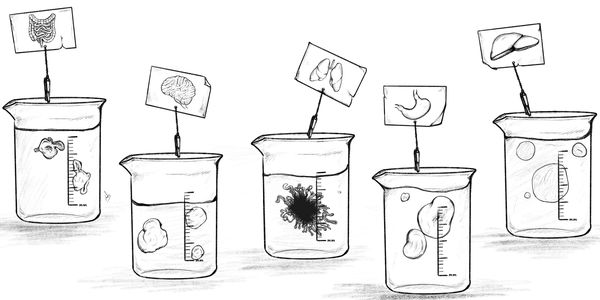
© Andreia S. Batista-Rocha
Organoids: Diversity and complexity. Made from stem cells, organoids can be produced for almost any human organ. The 3D cell structures, which are only a few millimeters in size, are fascinatingly complex. The illustration does not show real proportions.
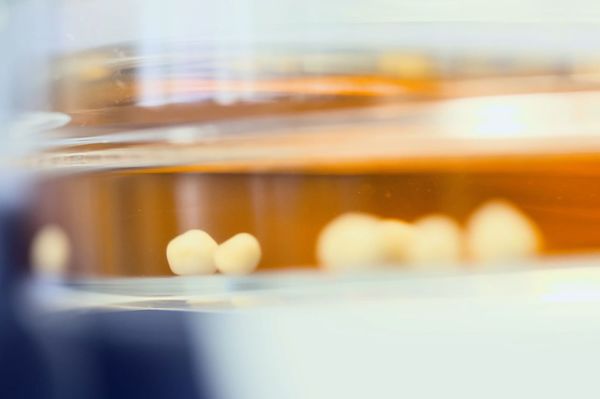
© GSCN/Jürgen Knoblich, IMBA, Wien
Human brain organoids. There are different brain organoids produced from pluripotent stem cells which mimic different regions of the brain. Specific ethical and legal issues raised by this type of organoids encompass questions such as whether advanced brain organoids could one day develop consciousness, how consciousness could be recognized and whether claims for protection of the respective organoids could be derived from such a recognition.
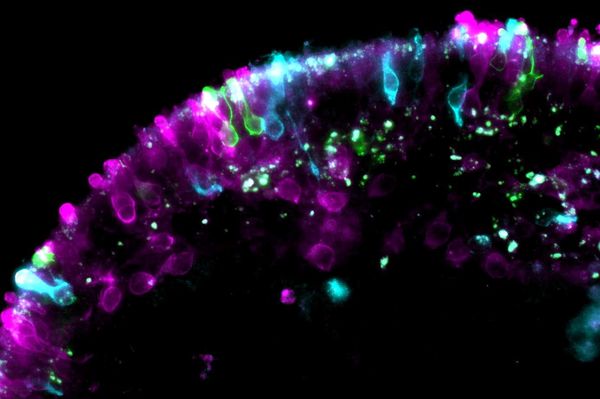
© Stefan Liebau, INDB 2020
Fluorescent dyed retinal organoid. A 1 millimeter retinal organoid can contain up to 300,000 photoreceptor cells. Such organoids are used in transplantation studies in blind mice with the long-term goal of producing transplantable organoids for the treatment of retinal disorders in humans. Other uses include the seeding of retinal organoids on a microscope slide that simulates the physiological conditions of the human eye, e.g. by artificial vessels and immune cells. These so-called retina-on-a-chip models enable the examination of drugs for side effects and could complement animal models.
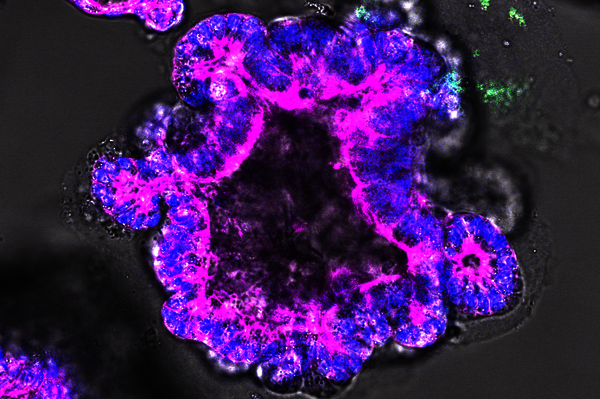
© Carolin Niklas, IMIB, Julius-Maximilians-Universität Würzburg
Human stomach organoids. These models can be used, for example, to simulate infections and cancers of the stomach in the laboratory, to investigate disease processes and to test possible drugs. It is hoped that the use of organoids in research and toxicity tests will reduce the number of animal experiments in the future and at the same time increase the reliability of research results.
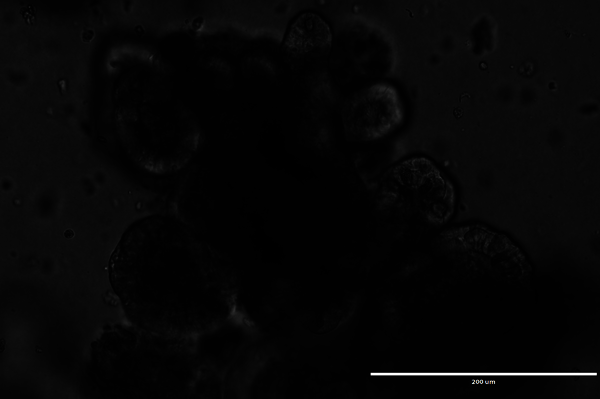
© Joep Baumer, Hans Clevers group, Hubrecht Institute, NL
Human intestinal organoid. Like the stomach, the intestine contains a large number of stem cells that enable the continuous regeneration of tissue. From these adult stem cells, organoids have been produced for several years, including patient-specific organoids stored in special organoid biobanks. These patient-specific organoids can be used, among other things, for the testing of patient-tailored drugs, which might enable a step towards personalized medicine, for example in cancer therapy.
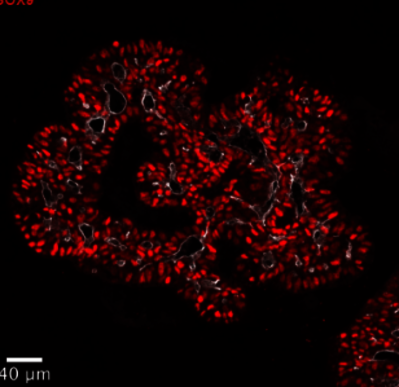
© Michael Larsen, DanStem, University of Copenhagen, DK
Human pancreatic organoid. In contrast to gastric and intestinal organoids, pancreatic organoids are produced on the basis of pluripotent stem cells. This pancreatic organoid is shown in cross section, the nuclei of pancreatic progenitor cells are stained red. An important goal of research on pancreatic organoids is to better understand the molecular mechanisms involved in the formation of insulin-producing beta cells and ideally to influence them in a targeted manner, i.e. to specifically differentiate them from progenitor cells. The researchers' vision is to cure diabetes patients by developing a cell replacement therapy in vivo.
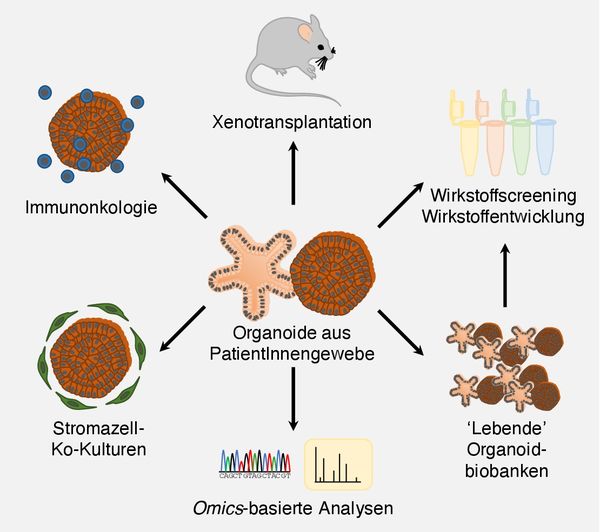
© Kai Kretzschmar, MSNZ Würzburg / SMART Servier Medical Arts
Possible applications of patient specific organoids in cancer research. Patient specific organoids in cancer research enable the investigation of various aspects of tumor development and metastasis, including the role of pathogens, genes and the cellular microenvironment. Further applications encompass the establishment of biobanks, drug screening and the development of personalized cancer therapies. Research into the role of the immune system in cancer development is being pursued in the rapidly developing field of immunoncology and can be enhanced by integrating immune cells into organoids.
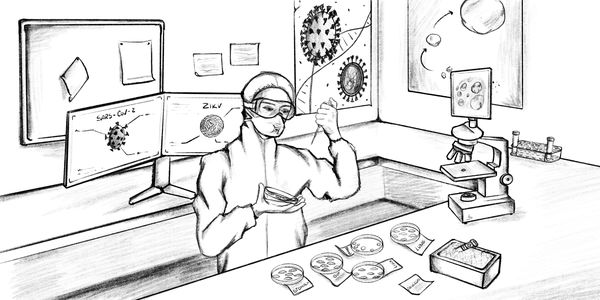
© Andreia S. Batista-Rocha
Tools of pandemic research. Organoids enable the modeling of infections of individual organs and thus help to understand what viruses such as SARS-CoV-2 or Zika cause in the body. Currently, especially lung, kidney, liver, pancreas and intestinal organoids are used to study the disease processes of COVID-19 and to screen existing drugs for efficacy against SARS-Cov-2.

© Andreia S. Batista-Rocha
Vision of the future: Human-on-a-Chip. More and more organoid systems can be linked via microchannels on a chip, thus allowing to investigate the interaction of different organs in multi-organ diseases. Multi-organoid chips produced in this way could one day be used for testing active ingredients in the pharmaceutical industry and possibly also for clinical studies. As a representative of a patient patient-specific organoid systems could help to find the best medication for an individual therapy. However, the reliability of the results of such tests on multi-organoid systems and their transferability to patients must first be validated. The illustration is greatly simplified and a complete representation of a human being on a chip is not possible in the foreseeable future.
We thank the German Stem Cell Network (GSCN) and the authors for providing the pictures.